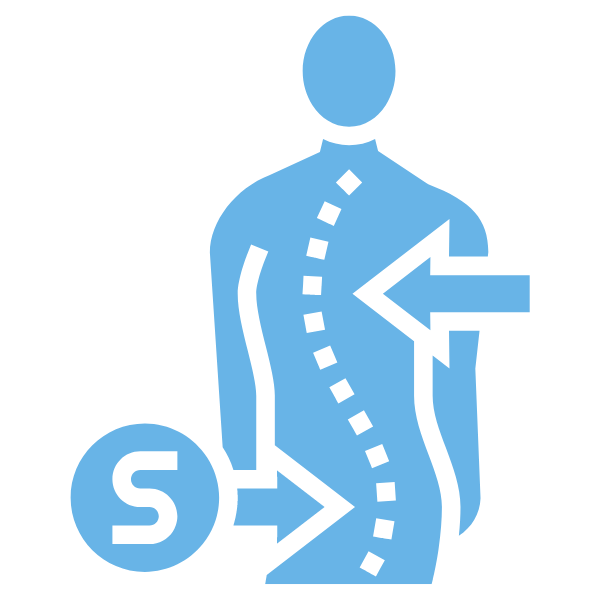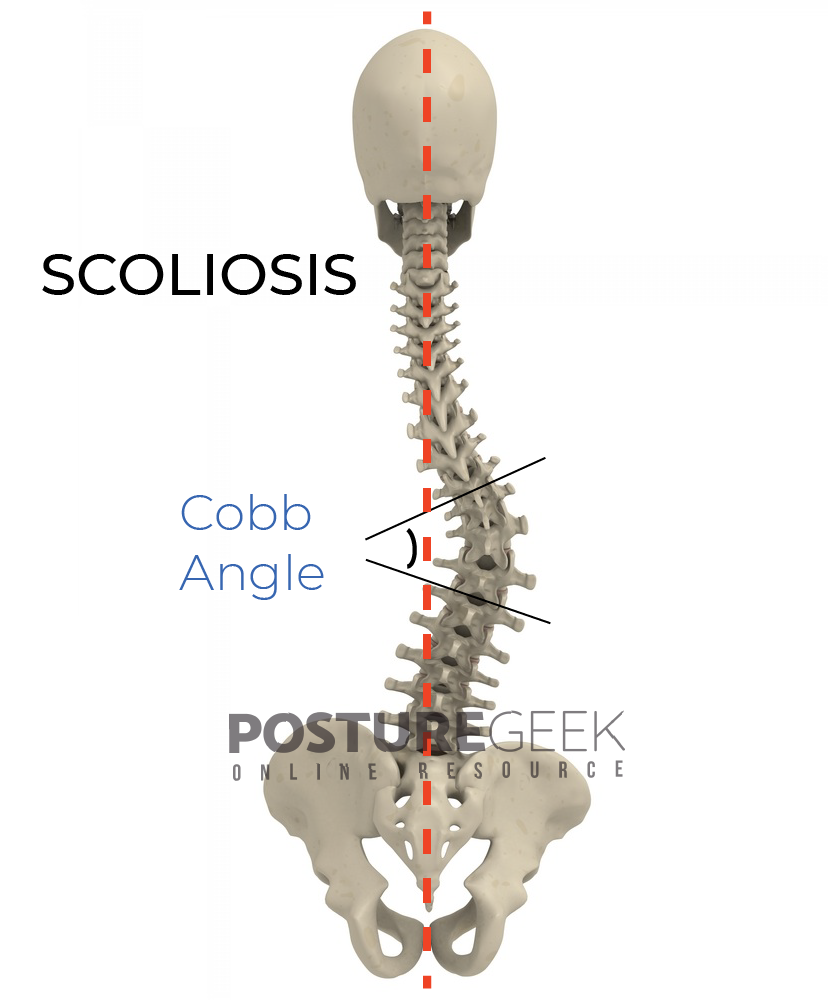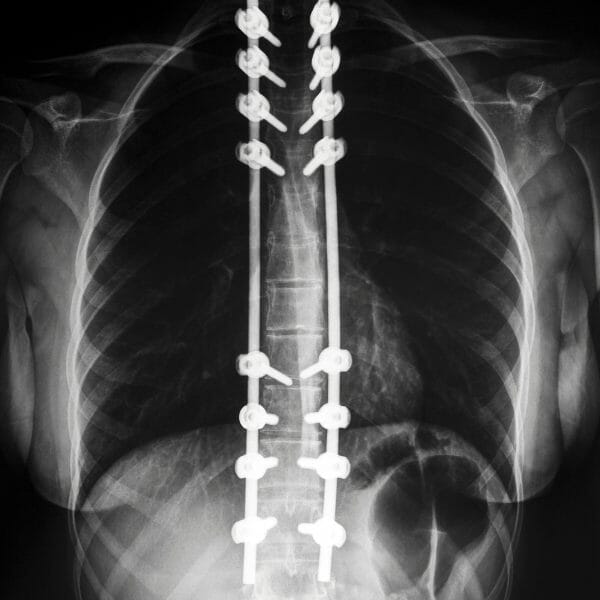Scoliosis Posture: How can you support your Scoliosis non-surgically?
Most people think of surgery as the only way to treat scoliosis, but that's not always the case. In fact, there are a number of ways you can support your scoliosis without surgery.
PostureGeek.com Tweet
Most people think of surgery as the only way to treat scoliosis, but that’s not always the case. In fact, there are a number of ways you can support your scoliosis without surgery. Let’s take a look at some of them.
What is scoliosis?

Scoliosis is a sideways curvature of the spine that typically appears during childhood or adolescence. The cause is unknown in most cases, but some people with scoliosis may have an underlying genetic condition.
While most people with scoliosis don’t experience pain or other problems, a small number may eventually need treatment. In some cases, the curvature of the spine can become severe enough to affect breathing and cause pain.
What are the symptoms of scoliosis?
The most common symptom of scoliosis is a noticeable curve in the spine. Spinal curvature may be S-shaped or C-shaped. The degree of curvature is described using the Cobb angle, which a doctor measures.
PostureGeek.com Tweet
The most common symptom of scoliosis is a noticeable curve in the spine. Spinal curvature may be S-shaped or C-shaped. The degree of curvature is described using the Cobb angle, which a doctor measures.
Other symptoms of scoliosis may include:
- Uneven shoulders
- One shoulder blade that appears more prominent than the other
- One hip that appears higher than the other
- Clothes that don’t fit well or feel tight across the back
- Back pain (although this is less common)
Why do I need to support my scoliosis non-surgically?
In most cases, scoliosis doesn’t cause any pain or other problems. However, a small number of people with the condition may eventually need treatment.
There are many reasons why you might want to support your scoliosis non-surgically. However, surgery is not always the best option and may not be necessary.
Many non-surgical treatments can help relieve pain and improve posture. Non-surgical treatments can also help prevent the progression of scoliosis.
How can you tell if you have bad posture or scoliosis?

There are many signs of overlapping posture issues and scoliosis. For example, if you have bad posture, you may have rounded shoulders, a forward head, and an increased curve in your lower back. You may also experience pain in your back, neck, and shoulders.
You may notice that your spine has a side-to-side curve if you have scoliosis. In addition, your shoulders may be uneven, and your hips may be rotated. You may also have one shoulder blade that sticks out more than the other.
Several overlapping elements may suggest you have posture concerns; however, the sideways (side bend) curve of the spine is a strong indicator that scoliosis may also be present.
What are the consequences of having bad posture and scoliosis?

Posture concerns and scoliosis can lead to back pain, muscle fatigue, and difficulty breathing. Poor posture can also make scoliosis worse. If scoliosis progresses, it can cause deformity and disability.
Over time, poor posture and scoliosis can lead to several health problems. These include:
- Back pain
- Neck pain
- Shoulder pain
- Headaches
- Digestive problems
- Joint pain
- Muscle fatigue
- Nerve compression
- Arthritis
- Disc degeneration
Scoliosis Treatment options: How can I support my scoliosis non-surgically?
Many non-surgical scoliosis treatment options can help relieve pain and improve posture. Non-surgical treatments can also help prevent the progression of scoliosis.
Get an accurate diagnosis

The first step is to get an accurate diagnosis from a qualified healthcare professional. Scoliosis can be difficult to diagnose, so it’s important to see someone familiar with it. Once you have a diagnosis, you and your healthcare team can develop a treatment plan that is right for you.
There is no single cause of scoliosis, but the condition may be caused by:
- congenital abnormalities,
- neuromuscular disorders, or
- degenerative diseases.
Non-surgical treatment options:
Your doctor may recommend a watch-and-wait approach if your curve is mild (less than 20 degrees) and isn’t progressing. This approach may be an option for children who have completed growth spurts and adults with mild scoliosis.
Your doctor may also recommend non-surgical treatments such as:
- Physical therapy to improve your flexibility and strengthen the muscles around your spine
- Exercise programs
- Orthotic devices, such as a brace, to support your spine and prevent further curvature
Surgery for severe scoliosis:

If non surgical treatments don’t stop the progression of your scoliosis, your doctor may recommend surgery. The type of surgery will depend on the severity of your condition.
The goal of scoliosis surgery is to stop the progression of the curve and relieve pain. Surgery may also be done to improve your appearance. Scoliosis surgery involves correcting the alignment of your spine and stabilizing it with metal rods, hooks, or screws.
After surgery, you’ll likely need to wear a brace for several months. You may also need physical therapy to help you regain strength and flexibility.
Work with a qualified healthcare professional
Suppose you have scoliosis that is causing you problems. In that case, it may be necessary to work with a qualified healthcare professional, such as a physiotherapist, chiropractor, or osteopath, who has experience treating the condition.
A qualified healthcare professional can help you design the right treatment plan and monitor your progress. They can also provide support and guidance as you manage your condition.
Choose the right treatment plan
There is no one-size-fits-all approach to treating scoliosis. The best treatment plan for you will depend on your curve’s severity, age, and overall health.
You and your doctor can work together to develop a treatment plan that’s right for you. Be sure to ask questions and voice any concerns about your treatment options.
Monitor your progress:
Once you start treatment, it’s essential to monitor your progress and keep track of any changes in your condition.
Your doctor may recommend regular checkups to monitor the progression of your scoliosis. You should also see your doctor if you experience any new pain or other changes in your condition.
You can manage your scoliosis and live a healthy, active life with the right treatment plan.
Wear a back brace
If you have scoliosis, you may need to wear a back brace. A back brace is a device you wear around your trunk to support your spine and prevent further curvature.
There are different types of back braces, and the type you need will depend on the severity of your scoliosis. Your doctor can help you find the right kind of brace for you.
Wearing a back brace can be uncomfortable, but it’s essential to wear it as directed by your doctor. Wearing a back brace will not cure scoliosis, but it can help stop the condition’s progression.
Participate in physical therapy
Physical therapy is an integral part of treatment for scoliosis. Physical therapy can help improve your flexibility and strengthen the muscles around your spine.
Your physical therapist will create a customized exercise program based on your needs. They can also teach you how to properly use a back brace if you need to wear one.
Make lifestyle changes

ENGAGE IN REGULAR EXERCISE
Exercise is important for people with scoliosis. Exercise can help improve your flexibility and strengthen the muscles around your spine.
Your doctor or health care provider can recommend specific exercises for you to do. There are also many yoga poses and stretches that can be helpful for people with scoliosis.
It’s important to start slowly and increase the intensity of your workouts gradually. Be sure to warm up before exercising and cool down afterwards. And listen to your body—if something hurts, stop doing it.
EAT A HEALTH DIET
Eating a healthy diet is essential for everyone, but it’s especially important for people with scoliosis. Eating a healthy diet can help you maintain a healthy weight, which is necessary for managing scoliosis.
A healthy diet includes plenty of fruits, vegetables, whole grains, and lean proteins. Limiting processed foods, sugary drinks, and saturated fats is also essential.
MANAGE YOUR STRESS
Stress can make scoliosis worse. That’s why it’s crucial to find ways to manage your stress.
There are many different ways to manage stress, such as yoga, meditation, and deep breathing exercises. Find what works best for you and stick with it.
GET ENOUGH SLEEP
Getting enough sleep is vital for everyone, but it’s especially important for people with scoliosis. When you sleep, your body has a chance to heal and repair itself.
Most people need at least 7 hours of sleep per night. If you have trouble sleeping, talk to your doctor about ways to improve your sleep habits.
SUPPORT GROUP
You may find it helpful to join a support group if you have scoliosis. A support group can provide you with emotional and practical support.
It can be helpful to talk to others who understand your situation. You can also get tips on how to manage your condition.
PAIN MANAGEMENT
If you have scoliosis, you may experience pain. Pain can be a symptom of scoliosis or a treatment side effect.
There are many pain management methods, such as over-the-counter medications, physical therapy, and massage. Your doctor can help you find the best way to manage your pain.
See your healthcare team regularly
If you have scoliosis, it’s essential to see your healthcare team regularly. They can monitor your progress and keep track of any changes in your condition.
Your doctor may recommend regular checkups to monitor the progression of your scoliosis. You should also see your doctor if you experience any new pain or other changes in your condition.
FAQ's
What is the difference between a back brace and physical therapy?
A back brace is a device that you wear to support your spine. Physical therapy is an exercise and stretching program designed to improve your flexibility and strengthen the muscles around your spine.
How long do I need to wear a back brace?
You will need to wear a back brace for as long as your doctor recommends. However, you will most likely need to wear the brace for at least 12 hours per day.
What are the best exercises for scoliosis?
The best exercises for scoliosis are those that improve your flexibility and strengthen the muscles around your spine. Your doctor or health care provider can recommend specific exercises for you to do.
Can scoliosis be cured?
Scoliosis cannot be cured, but it can be managed. There are many ways to manage scoliosis, such as wearing a back brace, exercising, and eating a healthy diet.
What is meant by adolescent idiopathic scoliosis?
Adolescent idiopathic scoliosis is the most common type of scoliosis. It affects children and adolescents between the ages of 10 and 16. The term “idiopathic” means that the condition’s cause is unknown.
Is surgical treatment necessary for scoliosis?
Surgery is not always necessary for scoliosis. In most cases, scoliosis can be managed without surgery. However, in some cases, surgical treatment may be recommended to improve the spine’s alignment and relieve pain.
Why would you wait before considering spinal surgery?
Spinal surgery is a significant operation. It is usually only considered when other treatments, such as wearing a back brace, have not worked. Surgery is also only considered if the scoliosis is progressing and causing pain. Patients must also consider spinal maturity before surgery is an option. Surgery is usually not considered until the child is at least 14 years old. This is because the spine continues to grow and change until adolescence. Surgery before this age in children with scoliosis may not be as effective.
PLEASE NOTE
PostureGeek.com does not provide medical advice. This information is for educational purposes only and is not intended to be a substitute for professional medical attention. The information provided should not replace the advice and expertise of an accredited health care provider. Any inquiry into your care and any potential impact on your health and wellbeing should be directed to your health care provider. All information is for educational purposes only and is not intended to be a substitute for professional medical care or treatment.
